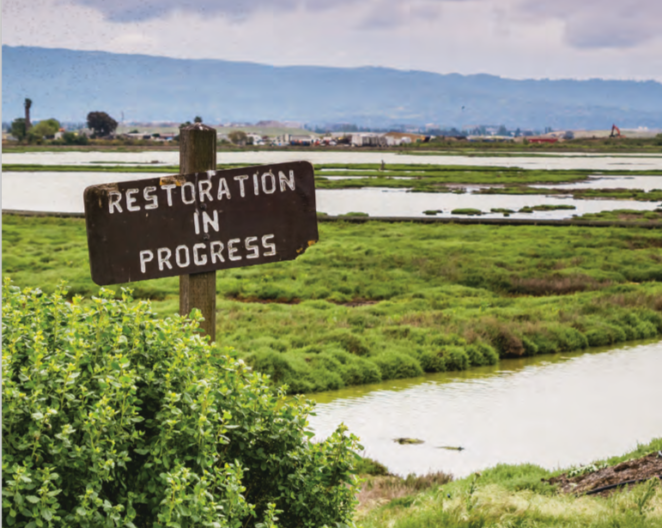Nature Based Solutions for Water: The United Nations World Water Development Report 2018

Introduction
Nature-based solutions (NBS) are inspired and supported by nature and use, or mimic, natural processes to contribute to the improved management of water. An NBS can involve conserving or rehabilitating natural ecosystems and/or the enhancement or creation of natural processes in modified or artificial ecosystems. They can be applied at micro- (e.g. a dry toilet) or macro- (e.g. landscape) scales.
Attention to NBS has significantly increased in recent years. This is evidenced through the mainstreaming of NBS into a wide range of policy advances, including in water resources, food security and agriculture, biodiversity, environment, disaster risk reduction, urban settlements, and climate change. This welcome trend illustrates a growing convergence of interests around the recognition of the need for common objectives and the identification of mutually supporting actions – as illustrated best in the 2030 Agenda for Sustainable Development through its acknowledgment of the interdependency of its various Goals and targets.
Upscaling NBS will be central to achieving the 2030 Agenda for Sustainable Development. Sustainable water security will not be achieved through business-as-usual approaches. NBS work with nature instead of against it, and thereby provide an essential means to move beyond business-as- usual to escalate social, economic and hydrological efficiency gains in water resources management. This report* provides an overview and recommendations for NBS within water management.
*Download the full report from the right-hand column. Also available in French and Spanish.
Key findings
The main findings of the report are as follows:
NBS for managing water availability
- NBS mainly address water supply through managing precipitation, humidity, and water storage, infiltration and transmission, so that improvements are made in the location, timing and quantity of water available for human needs.
- The option of building more reservoirs is increasingly limited by silting, decrease of available runoff, environmental concerns and restrictions, and the fact that in many developed countries the most cost-effective and viable sites have already been used.
- In many cases, more ecosystem-friendly forms of water storage, such as natural wetlands, improvements in soil moisture and more efficient recharge of groundwater, could be more sustainable and cost-effective than traditional grey infrastructure such as dams.
- Agriculture will need to meet projected increases in food demand by improving its resource use efficiency while simultaneously reducing its external footprint, and water is central to this need.
- NBS for addressing water availability in urban settlements are also of great importance, given that the majority of the world’s population is now living in cities. Urban green infrastructure, including green buildings, is an emerging phenomenon that is establishing new benchmarks and technical standards that embrace many NBS.
NBS for managing water quality
- Source water protection reduces water treatment costs for urban suppliers, and contributes to improved access to safe drinking water in rural communities.
- Forests, wetlands and grasslands, as well as soils and crops, when managed properly, play important roles in regulating water quality by reducing sediment loadings, capturing and retaining pollutants, and recycling nutrients.
- Where water becomes polluted, both constructed and natural ecosystems can help improve water quality.
- Non-point (diffuse) source pollution from agriculture, notably nutrients, remains a critical problem worldwide, including in developed countries.
- It is also the one most amenable to NBS, as these can rehabilitate ecosystem services that enable soils to improve nutrient management, and hence lower fertilizer demand and reduce nutrient runoff and/or infiltration to groundwater.
- However, there are limits to how NBS can perform. For example, NBS options for industrial wastewater treatment depend on the pollutant type and its loading.
NBS for managing water-related risks
- Water-related risks and disasters, such as floods and droughts associated with an increasing temporal variability of water resources due to climate change, result in immense and growing human and economic losses globally.
- Around 30% of the global population is estimated to reside in areas and regions routinely impacted by either flood or drought events.
- Ecosystem degradation is the major cause of increasing water-related risks and extremes, and it reduces the ability to fully realize the potential of NBS.
- Green infrastructure can perform significant risk reduction functions.
- Combining green and grey infrastructure approaches can lead to cost savings and greatly improved overall risk reduction.
NBS for enhancing water security: Multiplying the benefits
- NBS are able to enhance overall water security by improving water availability and water quality while simultaneously reducing water-related risks and generating additional social, economic and environmental co-benefits.
- They allow for the identification of win-win outcomes across sectors.
- For example, NBS in agriculture are becoming mainstream because they deliver increased sustainable agricultural productivity and profitability but also enhance overall system-wide benefits, such as improved water availability and reduced downstream pollution.
- Watershed restoration and protection has become increasingly important in the context of meeting multiple challenges in sustaining water supplies to rapidly growing cities and reducing risks in them.
Challenges and limitations
- Challenges to upscaling NBS so that they reach their full and significant potential are somewhat generic across the sectors and at global, region-specific or place-based scales.
- There remains a historical inertia against NBS due to the continuing overwhelming dominance of grey infrastructure solutions in the current instruments of the Member States – from public policy to building codes and regulations. This dominance can also exist in civil engineering, market-based economic instruments, the expertise of service providers, and consequentially in the minds of policy makers and the general public.
- These and other factors collectively result in NBS often being perceived to be less efficient, or riskier, than built (grey) systems.
- NBS often require cooperation among multiple institutions and stakeholders, something that can be difficult to achieve.
- Current institutional arrangements did not evolve with cooperation on NBS in mind.
- There are limits to what ecosystems can achieve and these need much better identification. For example, ‘tipping points’, beyond which negative ecosystem change becomes irreversible, are well theorized but rarely quantified. It is therefore necessary to recognize the limited carrying capacity of ecosystems and determine the thresholds where any additional stresses (e.g. the addition of contaminants and toxic substances) will lead to irreversible damage to the ecosystem.
- The high degree of variation in the impacts of ecosystems on hydrology (depending on ecosystem type or subtype, location and condition, climate and management) cautions to avoid generalized assumptions about NBS. For example, trees can increase or decrease groundwater recharge according to their type, density, location, size and age. Natural systems are dynamic and their roles and impacts change over time.
- An often overstated assumption about NBS is that they are ‘cost-effective’, whereas this should be established during an assessment, including consideration of co-benefits. While some small-scale NBS applications can be low- or no-cost, some applications, particularly at scale, can require large investments.
Enabling conditions for accelerating the uptake of NBS
- Leveraging financing andmaking more effective use of existing financing and/or redirecting funds and increasing overall recognition of the potential of ecosystem services to provide system-wide solutions.
- Creating an enabling regulatory and legal environmentby promoting NBS more effectively through existing frameworks. Current regulatory and legal environments for water management were developed with grey-infrastructure approaches in mind.
- Improving cross-sectoral collaboration,particularly when applied at landscape scale. In many countries, the policy landscape remains highly fragmented and there is a need for better harmonization of policies across economic, environmental and social agendas because of their ability to deliver multiple co-benefits beyond just hydrological outcomes.
- Improving the knowledge baseon NBS through more rigorous science and established evidence to help convince decision-makers of the viability of NBS.
Lessons Learnt
Looking forward, the report’s outlook can be summarised as follows:
- NBS offer high potential to contribute to the achievement of most of the targets of SDG 6 (on water). Areas in which this contribution translates into particularly striking positive direct impacts on other SDGs are with regards to water security for underpinning sustainable agriculture (SDG 2, notably Target 2.4), healthy lives (SDG 3), building resilient (water-related) infrastructure (SDG 9), sustainable urban settlements (SDG 11) and disaster risk reduction (SDG 11 and, as related to climate change, SDG 13). The co-benefits of NBS are particularly significant in relation to the ecosystem/environment-related SDGs, including the reduction of land use pressures on coastal areas and the oceans (SDG 14) and the protection of ecosystems and biodiversity (SDG 15).
- Increased deployment of NBS is central to meeting the key contemporary water resources management challenges of sustaining and improving water availability and quality, while reducing water-related risks. Without a more rapid uptake of NBS, water security will continue to decline, and probably rapidly so.
- NBS offer a vital means to move beyond business-as-usual. However, the necessity and opportunities for increased deployment of NBS remain underappreciated.
- The inadequate recognition of ecosystems’ roles in water management reinforces the need for transformational change, and increased uptake of NBS provides a means to achieve it. This transformational change can no longer just be aspirational – the shift needs to rapidly accelerate and, more importantly, translate into fully operationalized policy, with improved action at site level.
- The objective of NBS needs to be to minimize costs and risks, and maximize system returns and robustness, while providing optimal ‘fit-for-use’ performance. A role of policy should be to enable the right site-level decisions to be taken in these regards.
- We have made a good, if somewhat belated, start in this process but there is a long way yet to go.

Suggested citation
WWAP (United Nations World Water Assessment Programme)/UN-Water. 2018. The United Nations World Water Development Report 2018: Nature-Based Solutions for Water. Paris, UNESCO.
Further reading
- Integrated Water Management in Nicaragua: Rethinking Best Practice
- Climate-Resilient Water Management: An operational framework from South Asia
- Increasing Water Efficiency through Agricultural Drainage Water Reuse in the Nile Delta, Egypt
- Impact, vulnerability and adaptation in Africa: the competition for water
(0) Comments
There is no content